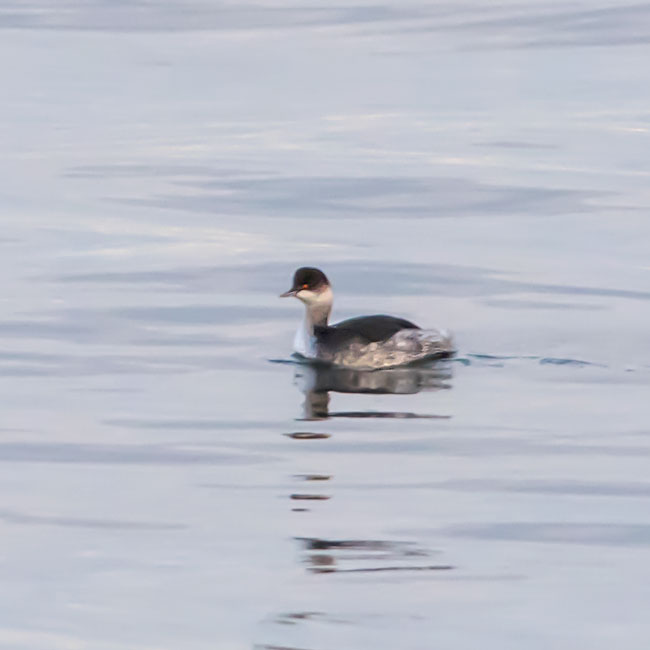
| Black-necked Grebe |
| Winter Plumage Taken at Musselburgh on 23rd December 2018 using Nikon D500 with Sigma 600 mm zoom lens. |

| Black-necked Grebe. |
| Species: Order: Family: Local names: |
Podiceps nigricollis. Podicipediformes. Podicipedidae |
| Site Of Nest: Food: Plumage: Breeding Period: Eggs: |
Primarily saline
lakes and coastal estuaries A floating cup nest, anchored by plant material. Mostly insects, as well as crustaceans, molluscs, tadpoles, small frogs and fish. Breeding plumage: The head, neck, breast, and upper parts are coloured black to blackish brown, with the exception of the ochre-coloured fan of feathers extending behind the eye over the eye-coverts and sides of the nape. This eye is mostly red, with a narrow and paler yellow ring on the inner parts of the eye and an orange-yellow to pinkish-red orbital ring. The thin bill is black, and is connected to the eye by a blackish line starting at the gape. The upperwing is blackish to drab brown in colour and has a white patch formed by the secondaries and part of the inner primaries. The flanks are coloured tawny rufous to maroon-chestnut and have the occasional blackish fleck. The underwing and abdomen is white, with an exception to the former being the dark tertials and the mostly pale grey-brown outer primaries. The legs are a dark greenish grey. The sexes are similar. Non-breeding plumage: Greyish-black upper parts, cap, nape, and hindneck, with the colour on the upper portion of the latter being contained in a vertical stripe. The dark colour of the cap reaches below the eye and can be seen, diffused, to the ear-coverts. Behind the ear-coverts on the sides of the neck, there are white ovals. The rest of the neck is grey to brownish-grey in colour and has white that varies in amount. The breast is white,and the abdomen is whitish. The flanks are coloured in a mix of blackish-grey with white flecks. The bill is significantly more grey. In the Northern Hemisphere, this bird breeds from April to August. In east Africa, the breeding season is at least from January to February, while in southern Africa, the breeding season is from October to April. A clutch, sometimes two, of three to four chalky greenish or bluish eggs |
| Voice |
